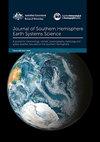利用卫星红外图像跟踪和短期预报巴西东南部中尺度对流云团
IF 3.6
4区 地球科学
Q1 Earth and Planetary Sciences
引用次数: 0
摘要
本文介绍了2009 - 2017年发生在巴西东南部和邻近大西洋的中尺度对流云团的跟踪和短期预报。这些事件产生强降雨和严重风暴,影响农业、国防、水力发电和海上石油生产。为了识别、跟踪和预测CCs,采用了地球静止业务环境卫星红外图像和预测和跟踪云团演变方法。通过对观测到的和预测到的CCs的物理性质进行统计分析,考察了预测效果。对7139个中尺度对流cc进行了识别、跟踪和选择,用于成熟阶段的短期预报。CC跟踪显示,在雨季,CC在大西洋上空频率高,主要在巴西东南部大陆和沿海地区。这表明冷锋和对流日强迫对该地区对流云量的组织起了重要作用。大多数CCs在生命周期的前2h内达到成熟阶段,主要发生在下午晚些时候和晚上之间。cc寿命短,以中-β尺度为主,其次是中-α对流cc。CCs显示的云顶温度是具有强垂直发展和降雨潜力的云的典型特征。CCs成熟期的短期预测显示出不同统计指标在预测范围内的不同行为。在30 - 60分钟的时间段内,预测表现相对较好。对于较长的预报提前时间(90 - 120分钟),预报高估了CCs的发生、强度和增长,并预测CCs将在实际观测位置的更北和更东的地方。总的来说,我们的研究结果可能有助于提高这些强烈天气事件的预报质量。本文章由计算机程序翻译,如有差异,请以英文原文为准。
Tracking and short-term forecasting of mesoscale convective cloud clusters over southeast Brazil using satellite infrared imagery
This paper presents the tracking and short-term forecasting of mesoscale convective cloud clusters (CCs) that occurred over southeast Brazil and the adjacent Atlantic Ocean during 2009–17. These events produce intense rainfall and severe storms that impact agriculture, defence, hydroelectricity and offshore oil production. To identify, track and forecast CCs, the Geostationary Operational Environmental Satellite infrared imagery and the Forecasting and Tracking the Evolution of Cloud Clusters method are used. The forecast performance is investigated by applying statistical analyses between the observed and forecasted CCs’ physical properties. A total of 7139 mesoscale convective CCs were identified, tracked and selected for the short-term forecasting at their maturation phases. The CC tracking showed a high frequency of CCs over the Atlantic Ocean and mainly over continental and coastal southeast Brazil during the wet season. This indicates an important role played by the cold fronts and convective diurnal forcing on the organisation of convective cloudiness over that region. The majority of the CCs reached their maturation phases within the first 2h of life cycle, which occurred mostly between the late afternoon and evening. The CCs had short lifetimes and were predominantly in meso-β scales, followed by meso-α convective CCs. The CCs showed cloud-top temperatures typical of clouds with strong vertical development and potential to produce rainfall. The short-term forecasting of CCs at their maturation phases revealed different behaviours of the statistical indices with forecast range. For the 30–60-min timeframe, the forecasts performed relatively well. For longer forecast lead times (90–120min), the forecasts overestimated the occurrences, intensities and growth of the CCs and forecasted the CCs to be further north and east of their actual observed locations. Overall, our results may contribute to improving the forecast quality of these intense weather events.
求助全文
通过发布文献求助,成功后即可免费获取论文全文。
去求助
来源期刊

Journal of Southern Hemisphere Earth Systems Science
Earth and Planetary Sciences-Oceanography
CiteScore
8.10
自引率
8.30%
发文量
0
审稿时长
>12 weeks
期刊介绍:
The Journal of Southern Hemisphere Earth Systems Science (JSHESS) publishes broad areas of research with a distinct emphasis on the Southern Hemisphere. The scope of the Journal encompasses the study of the mean state, variability and change of the atmosphere, oceans, and land surface, including the cryosphere, from hemispheric to regional scales.
general circulation of the atmosphere and oceans,
climate change and variability ,
climate impacts,
climate modelling ,
past change in the climate system including palaeoclimate variability,
atmospheric dynamics,
synoptic meteorology,
mesoscale meteorology and severe weather,
tropical meteorology,
observation systems,
remote sensing of atmospheric, oceanic and land surface processes,
weather, climate and ocean prediction,
atmospheric and oceanic composition and chemistry,
physical oceanography,
air‐sea interactions,
coastal zone processes,
hydrology,
cryosphere‐atmosphere interactions,
land surface‐atmosphere interactions,
space weather, including impacts and mitigation on technology,
ionospheric, magnetospheric, auroral and space physics,
data assimilation applied to the above subject areas .
Authors are encouraged to contact the Editor for specific advice on whether the subject matter of a proposed submission is appropriate for the Journal of Southern Hemisphere Earth Systems Science.
 求助内容:
求助内容: 应助结果提醒方式:
应助结果提醒方式:


